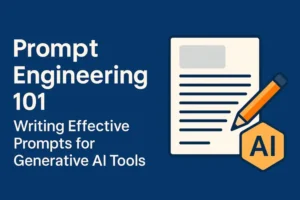Master the art of writing prompts that deliver accurate, creative, and relevant results with the power of generative engine optimization (GEO)
Introduction
We are living in the era of artificial intelligence, where a single prompt can generate entire articles, marketing campaigns, or even functional code. But here’s the catch — not all prompts are created equal. The quality of your results from tools like ChatGPT, Google Gemini, and Claude depends heavily on how well you design your prompt. This process is called prompt engineering.
When combined with generative engine optimization (GEO), prompt engineering can give your content a powerful edge, ensuring that it not only serves your immediate needs but also ranks in AI-driven search results. This blog will walk you through everything you need to know about writing effective prompts, integrating GEO strategies, and choosing the best AI tools for the job.
What is Prompt Engineering?
Prompt engineering is the art and science of creating instructions for AI tools that guide them to produce the most accurate, relevant, and useful output possible. Just like a chef needs a detailed recipe to prepare a dish perfectly, an AI model needs a well-crafted prompt to deliver the results you expect.
For example, instead of saying: “Write about SEO”, you might say: “Write a 1000-word beginner’s guide to SEO with examples, tips, and a step-by-step checklist.” This clarity drastically improves the quality of output.
With the growth of generative engine optimization (GEO), prompt engineering isn’t just about getting better AI results — it’s about structuring queries so that AI-driven search engines present your content to more users.
How Prompt Engineering Connects with GEO
Traditional SEO focuses on optimizing content for search engines like Google. Generative engine optimization (GEO) takes it a step further by optimizing your content so it’s more likely to be selected and surfaced in answers generated by AI systems.
When AI tools generate responses, they look for content that is:
- Rich in relevant, natural keywords
- Well-structured with clear headings, lists, and examples
- Highly contextual and precise
- Written in a conversational but authoritative tone
By designing prompts that encourage AI to produce such content, you’re effectively implementing GEO at the very start of the content creation process.
Best Practices for Writing Prompts in Generative AI
When writing prompts for generative AI tools, keep these principles in mind:
- Be Specific and Detailed: A vague prompt leads to vague results. Define length, tone, format, and purpose.
- Provide Context: Tell the AI who the audience is, what they know, and what they need to learn.
- Request Structure: If you want headings, bullet points, or tables, specify them.
- Use Examples: Show the AI exactly what style or structure you’re aiming for.
- Incorporate GEO Keywords: Naturally insert relevant terms like “generative engine optimization (GEO)” so the AI includes them in the final content.
Examples of Strong vs. Weak Prompts
Weak Prompt:
Write about AI tools.
Strong Prompt:
Write a 1200-word blog post explaining the top 5 AI tools for content creation, including pros, cons, pricing, and how they can be used in generative engine optimization (GEO). Structure the content with headings, subheadings, and bullet points.
The second prompt sets a clear expectation for length, topic, format, and keyword usage, making it more effective.
What is the Best AI Tool for Writing Prompts?
Different AI tools have unique strengths when it comes to prompt engineering:
- ChatGPT (OpenAI): Best for versatility and creative content generation. Excellent for testing variations of prompts.
- Google Gemini: Strong in research-based and up-to-date answers due to its integration with live web data.
- Claude (Anthropic): Great for longer, nuanced content with high safety and context awareness.
- PromptPerfect: A dedicated tool for refining prompts and applying generative engine optimization (GEO) principles for better AI output.
Advanced GEO Prompt Strategies
To merge prompt engineering with generative engine optimization (GEO), follow these advanced tips:
- Start prompts with the target keyword naturally.
- Use long-tail variations and synonyms within prompts.
- Request AI to include FAQ sections, summaries, and meta descriptions for SEO + GEO benefits.
- Ask AI to provide answers in multiple formats (paragraph + list + table) to appeal to different content retrieval models.
- Include real-world examples and case studies in your prompt request.
Common Prompt Engineering Mistakes to Avoid
- Being too vague or too broad in instructions.
- Ignoring the target audience’s level of knowledge.
- Failing to request a specific tone or style.
- Overloading prompts with too many unrelated requests.
- Forgetting to incorporate generative engine optimization (GEO) keywords for visibility in AI results.
FAQs about Prompt Engineering & GEO
Which is the best practice for writing prompts in generative AI?
The best practice is to be specific, provide context, define format, and include GEO-friendly keywords naturally. This ensures both high-quality output and better AI search visibility.
What is prompt engineering for generative AI tools?
Prompt engineering is crafting precise instructions for AI tools so they produce relevant, high-quality outputs. When combined with generative engine optimization (GEO), it ensures content is optimized for AI-driven discovery.
What is the best AI tool for writing prompts?
ChatGPT is the most versatile for testing and refining prompts, but tools like Gemini, Claude, and PromptPerfect also excel in different areas.
Conclusion
Prompt engineering is no longer an optional skill — it’s essential in today’s AI-powered digital world. By combining it with generative engine optimization (GEO) strategies, you can create content that’s not only accurate and engaging but also primed for visibility in AI-generated search results. Whether you’re a content creator, marketer, or business owner, mastering this skill will future-proof your digital presence.
